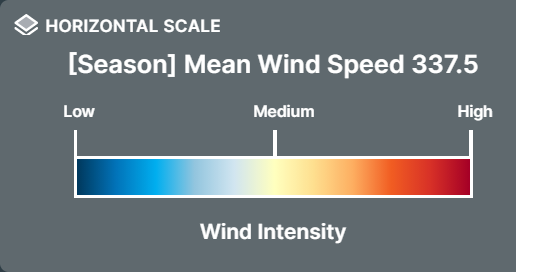Pedestrian Level Wind Color Legend
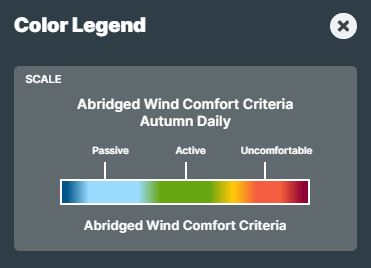
What is it measuring?
Pedestrian wind comfort (i.e. the perceived acceptability of the force of wind on a person). Abridged Comfort Criteria is a simplified version of RWDI’s criteria
What does the scale mean?
The color scale indicates three types of zones. These indicate what a specific location is best suited for (80% of the time or more, statistically):
- Passive – Calm or light breezes desired for outdoor restaurants
- Active – Moderate winds that would be appropriate for window shopping or strolling down a street, plaza or park
- Uncomfortable – Strong winds considered a nuisance for all pedestrian activities, mitigation typically recommended
What options can I specify?
The Season is defined by the user (or predefined for them) by specifying a range of months. All 24 hours in a day are used
Directional Wind Color Legend
What is it measuring?
The average wind speed at a location for a defined season and wind direction (337.5 is NNW)
What does the scale mean?
The color scale indicates three types of zones; low, medium and high. These indicate a relative wind speed/intensity for a given area. The colors should not be taken as an absolute; they are meant to only indicate whether a specific location is expected to experience acceleration or deceleration of wind intensity
- Blue indicates low wind speed regions that are comfortable for relaxed and passive activities
- Yellow indicates medium wind speed regions that are comfortable for strolling and active use
- Red indicates high wind speeds that are associated with high wind speed regions that may not be suitable for pedestrian use.
What option can I specify?
The Season is defined by the user (or predefined for them) by specifying a range of months.
Thermal Comfort – SPMV HOT – Color Legend (Hot and Tropical) Climates
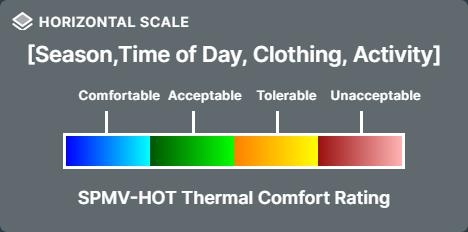
SMPV*
In an outdoor environment, the “Standard Predicted Mean Vote Modified” (SPMV*) metric is used as it can effectively account for the physics associated with elevated solar exposure and humidity ranges present outdoors. SPMV* is a modified version of the ASHRAE PMV metric which better accounts for the larger range of outdoor conditions.
Thermal comfort is a useful concept and SPMV* provides a method to communicate this concept. Still, it should be noted that the SPMV* index is based on surveys and perceptions of individuals. It is based on 80% of respondents agreeing on the condition they are feeling. It is, in no way, a definitive measure of an individual’s thermal comfort. Also, the variety of conditions and activities that impact the perception of comfort are large and varied.
Any thermal comfort analysis should therefore be viewed as a guide and not as a quantitative assessment.
What is it measuring?
Thermal Comfort scale for a given season (range of months), time of day period (range of hours), clothing and activity level. Thermal comfort is finding a perfect balance when people in outdoor spaces aren’t too cold, too warm, and when it’s neither too sunny, too cold, nor too windy for pedestrians.
What does the scale mean?
This is a SPMV* for hot and tropical climates. The color scale shows what the average thermal comfort conditions are at a location.
The color scale indicates four types of zone:
- Comfortable: this location is similar to indoors. No thermal stress.
- Acceptable: A person will generally accept this location as comfortable since they are outdoors. Some thermal stress.
- Tolerable: A person will stay at this location for some time but will seek better conditions.
- Unacceptable: Too hot. A person will seek cooler conditions.
What options can I specify?
The Season, Time of Day, Clothing Type and Activity Type is defined by the user (or predefined for them). Example:
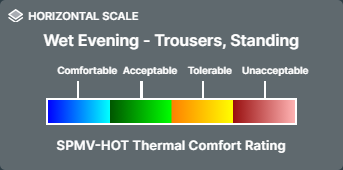
Thermal Comfort – SPMV – Color Legend (Temperate) Climates
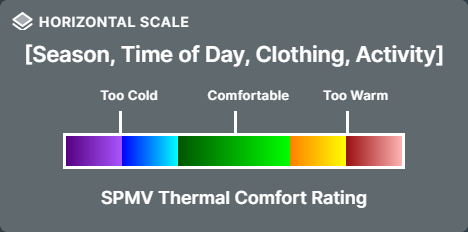
SPMV*
In an outdoor environment, the “Standard Predicted Mean Vote Modified” (SPMV*) metric is used as it can effectively account for the physics associated with elevated solar exposure and humidity ranges present outdoors. SPMV* is a modified version of the ASHRAE PMV metric which better accounts for the larger range of outdoor conditions.
Thermal comfort is a useful concept and SPMV* provides a method to communicate this concept. Still, it should be noted that the SPMV* index is based on surveys and perceptions of individuals. It is based on 80% of respondents agreeing on the condition they are feeling. It is, in no way, a definitive measure of an individual’s thermal comfort. Also, the variety of conditions and activities that impact the perception of comfort are large and varied.
Any thermal comfort analysis should therefore be viewed as a guide and not as a quantitative assessment.
What is it measuring?
Thermal Comfort scale for a given season (range of months), time of day period (range of hours), clothing and activity level. Thermal comfort is finding a perfect balance when people in outdoor spaces aren’t too cold, too warm, and when it’s neither too sunny, too cold, nor too windy for pedestrians.
What does the scale mean?
This is a SPMV* for temperate climates. The color scale shows what the average thermal comfort conditions are at a location.
The color scale indicates three types of zone:
- Comfortable – this location is similar to indoors. No thermal stress.
- Too Cold/Too Warm – a person will stay at this location for some time but will seek better conditions.
What options can I specify?
The Season, Time of Day, Clothing Type and Activity Type is defined by the user (or predefined for them).
Thermal Comfort – SPMV % Inbounds Color Legend
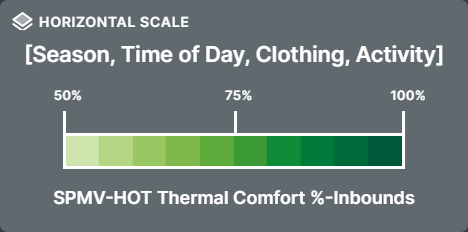
SPMV*
In an outdoor environment, the “Standard Predicted Mean Vote Modified” (SPMV*) metric is used as it can effectively account for the physics associated with elevated solar exposure and humidity ranges present outdoors. SPMV* is a modified version of the ASHRAE PMV metric which better accounts for the larger range of outdoor conditions.
Thermal comfort is a useful concept and SPMV* provides a method to communicate this concept. Still, it should be noted that the SPMV* index is based on surveys and perceptions of individuals. It is based on 80% of respondents agreeing on the condition they are feeling. It is, in no way, a definitive measure of an individual’s thermal comfort. Also, the variety of conditions and activities that impact the perception of comfort are large and varied.
Any thermal comfort analysis should therefore be viewed as a guide and not as a quantitative assessment.
What is it measuring?
A SPMV thermal comfort scale showing the percentage of time an area is perceived as comfortable
What does the scale mean?
The color scale indicates the percentage of hours within a specified time frame that are within the comfortable range. Example:
- 100% = All hours of the specified criteria (Season, Time of Day etc) and are comfortable in the location colored dark green
What options can I specify?
The Season, Time of Day, Clothing Type and Activity Type is defined by the user (or predefined for them).
Solar (% Sun Lit) Color Legend
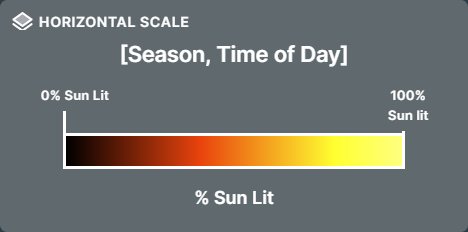
What is it measuring?
A theoretical shading scale that measures if the sky was clear every day of the year, this is where shadows would fall for the given Season (month range) and Time of Day (hour range)
What does the scale mean?
The color scale indicates the amount of shadow and/or sunlight an area is experiencing:
- Black – fully shaded
- Bright Yellow – full sun
0% means a location does not see direct sun at any time during the specified Season and Time of Day. 100% means it is never shaded and completely exposed to the sun.
What options can I specify?
The Season and Time of Day
Directional Wind Color Legend

What is it measuring?
Average wind speeds at a location for a given season and wind direction
What does the scale mean?
The color scale indicates three types of zones; low, medium and high. These indicate a relative wind speed/intensity for a given area. The colors should not be taken as an absolute; they are meant to only indicate whether a specific location is expected to experience acceleration or deceleration of wind intensity.
The streamlines show how and where the wind flows around the buildings and space
What options can I specify?
None, this scale shows a relative flow and the plots are not seasonal nor scaled for climate data. Year-round conditions are used
